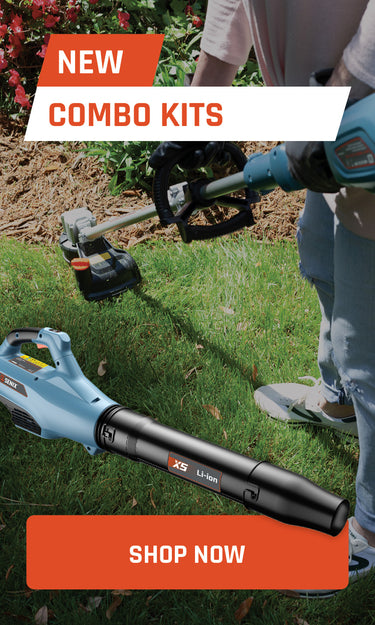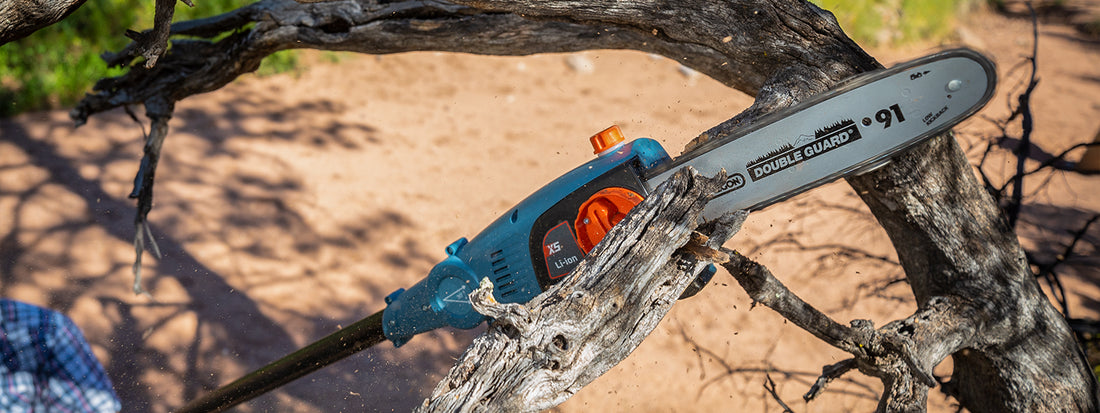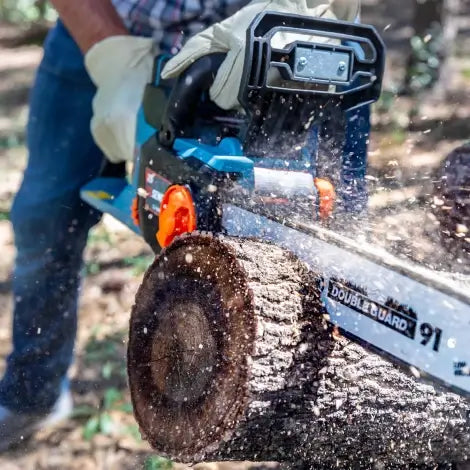Proper tree trimming (also called pruning) provides many advantages for not only your trees but also the people and property nearby. Here we have gathered helpful tips for how and when to trim your trees, as well as answers to a few specific questions we commonly hear.
Why is tree trimming important?
Three main reasons drive why tree trimming is important: appearance, health, and safety.
Appearance
Tree trimming enhances a tree’s physical appearance and can greatly impact the overall aesthetic of your lawn. You can prevent a tree from looking scraggly and unbalanced by removing unwieldy branches. You can also trim to thin out the crown of the tree (called crown thinning) to enhance the tree’s access to air and sunlight. (Avoid removing too many branches from the center as this may affect the overall structure of the tree.) Trimming lower branches from the tree crown (called crown lifting) can lighten the look of the tree. This also serves the purpose of clearing sidewalks and driveways, as well as removing branches that encroach on your home’s structure. Use caution when crown-lifting fully grown trees. The tree’s lower branches will be large and leave significant wounds on the tree. This type of trimming is best suited for younger trees. When timed properly, pruning a tree can also improve flowering and fruit production. By reducing the number of a tree’s branches, the remaining branches receive more nutrients from the soil, allowing the tree to produce healthier fruit and flowers. (Check out the FAQ section below for details on when to prune flowering trees.)
Health
General overgrowth and an abundance of dead, dying, or diseased branches can compromise a tree’s overall health. Think of regular tree trimming or pruning as good hygiene for your tree. Pruning helps create a healthier root system and core structure for the tree, strengthening it to withstand the elements, and prevent sick branches from spreading disease. Trees absorb essential nutrients from the soil via the root system, and trimming branches helps your tree effectively absorb and utilize those nutrients. Without trimming, the tree wastes valuable nutrients on excess branches, which compromises the health of the entire tree. By removing some of the excess branches, the tree develops a more robust root system that can better use the available nutrients. Sunlight is another essential ingredient in your tree’s health. Trees rely on the sunlight to produce nutrients through a process called photosynthesis. The tree’s ability to complete photosynthesis depends not only on the number of leaves on your tree, but also on the amount of sun that reaches those leaves. Densely packed branches can hide many leaves from the sun and reduce photosynthesis. Trimming the unnecessary branches enables the tree to get more sunlight. While trimming your trees, you can also detect diseases that may be present. Early detection allows you to prevent the disease from spreading further within the tree or to other trees. We advise reporting tree disease concerns to a specialist in case treatment is needed.
Safety
Along with impacting a tree’s appearance and health, dead or diseased branches pose a safety hazard. When faced with heavy storms or strong winds, weakened branches can easily fall. (Be assured: it is not a question of if dead branches will fall, but when.) Additionally, proper trimming helps keep the tree’s roots strong. A strong root system is what keeps the giant tree in your yard from falling over when heavy rains saturate the ground. By removing dead branches early, you minimize the risk of injury or property damage from falling branches or toppling trees. It’s also important to consider that even healthy branches can pose a risk to your siding or windows if they’re too close. When a tree isn’t trimmed properly, branches can grow too close to power lines or to your home. Proper trimming helps keep low branches away from sidewalks and driveways, keeping everyone safe.
How often do trees need to be trimmed?
According to the
Arbor Day Foundation, trees need to be trimmed or pruned once yearly; the time of year depends on why you’re pruning them. Trimming to cut out dead or diseased branches can (and should) be done as often as needed. If you want to encourage new growth in spring for a fuller crown, trim/prune in winter when the tree is dormant. If your goal is to dwarf or slow growth in parts of the tree to achieve a desired shape, trim/prune in summer, soon after the tree’s seasonal growth is complete.
Tree Trimming Tools
If you need to cut branches or limbs that are beyond the reach of a
chain saw, you’ll want a pole saw. Essentially, a
pole saw is a chain saw mounted at the end of a pole, and it is the ideal tree trimming tool. Choose a pole saw that is not only powerful enough for the job but also safe, reliable, and easy to handle. Senix pole saws pack immense power into a lightweight, easy-to-manage tool with options including 8”-10” bars and rods that extend up to 15 feet reach. Be sure to shop our full collection, which includes
gas-powered,
corded electric, and
cordless electric pole saws.
Tree Trimming Safety
Always remember to wear a hardhat and safety glasses to protect your head and eyes from branches that may be a falling hazard, and NEVER use a ladder when trimming a tree. If you can’t reach it with your
pole saw, while your feet are planted firmly on the ground, then you need to call in a pro. (Most pole saws can extend between 8 and 15 feet; if you add the pole extension length to your own height plus arm length, you’ve got your potential cutting reach.) For more on tree trimming safety, see our article on
How to Safely Use a Pole Saw. If you invest in
the right tools and follow safety precautions, you (and your trees) can reap all the benefits of proper tree trimming. Read on for answers to a few of the tree trimming questions we hear most often.
Tree Trimming FAQs
When should you trim maple trees?
The best time to prune maple trees is in summer after the tree is in full leaf. Summer trimming reduces sap bleeding (when sap runs out of the tree after it is trimmed or pruned) and minimizes exposure to maple tree diseases. Sap bleeding is most noticeable when trimming in winter or spring because the warmer days and colder nights increase root pressure, causing the sap to flow more freely from cuts. However, in summer, after the leaf buds open, the sap is no longer under pressure. Although losing sap does not harm a mature maple tree, it can be an invitation to pests. Avoid pruning maple trees in the fall because damp conditions and falling leaves encourage various maple tree diseases. (The exception to this is when you need to remove dead or diseased branches – this can be done any time of year.)
When should you trim flowering trees?
In order to know when to trim a flowering tree, you first need to know when the tree blooms. If the tree blooms in summer (after the end of June), wait until late winter or early spring then trim it before it starts new growth. The pruning will encourage healthy new growth when it begins. These plants develop flower buds during the spring, just before their flowering season. Examples of summer blooming trees include crape myrtles and magnolia trees. If the tree blooms in spring, trim it right after it stops flowering. This is essential because flower buds in these trees develop during the previous season’s growth. If pruned in late winter or early spring (before spring flowering), the flower buds will be lost and you will lose that season’s flowering. Examples of trees that bloom in spring include crabapple trees, dogwoods, and flowering cherry trees.
Who is responsible for trimming trees overhanging a neighbor’s yard?
If you have a tree on your property that overhangs a neighbor’s yard, you are responsible for the tree itself. However, the neighbor is responsible for, and permitted to, trim branches that extend onto their property. A neighbor may cut branches back to the property line, but they may not destroy the tree. Keep in mind that, as the tree owner, you are responsible for trimming weak or damaged branches – even those that extend into a neighbor’s yard. If a weak or damaged branch (that you failed to remove or maintain) falls into the neighbor’s yard and causes damage, you are legally responsible. However, you are not responsible for debris like leaves or acorns that fall into the neighbor’s yard.
Who is responsible for trimming trees near power lines?
Who is responsible for trimming trees near power lines depends on the tree’s location and whether it is touching the power line. If your tree is growing out over public land and near power lines, the power company will trim your tree. However, trees on your property are your responsibility, and if they are near power lines, you should trim them. Having said that, since the utility company can access power lines on your premises regardless, some cities may come in and trim the trees themselves. (In most cities, though, an inspector will go around and notify residents if their trees are near power lines and must be trimmed.) If a tree is touching a power line, the electric company is responsible for trimming it. In fact, the electric company is required to do so by the National Electrical Safety Code because branches can conduct electricity. To avoid the risk of electric shock, never trim a tree yourself if it is touching a power line.



















Leave a comment
Please note, comments need to be approved before they are published.